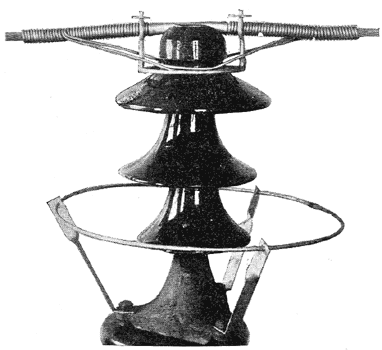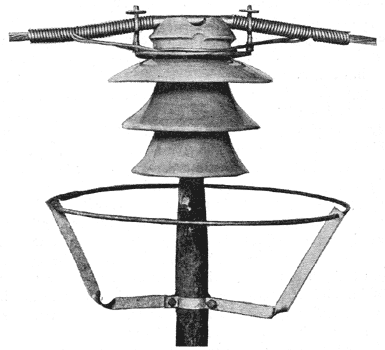[Trade Journal]
Publication: Electrical World
New York, NY, United States
vol. 57, no. 12, p. 727, col. 1-2
PROTECTION AFFORDED BY ARCING RINGS ON TRANSMISSION LINES.
BY L. C. NICHOLSON.
A PAPER read before the American Institute of Electrical Engineers at Charlotte, N. C., in March, 1910, described the effects of lightning upon the 60,000-volt transmission lines of the Niagara, Lockport & Ontario Power Company and showed the marked degree of relief obtained by applying metal arcing rings to the insulators, as shown in Figs. 1 and 2.
The object of these rings is to save the insulator from injury the power arc following a flashover by lightning. They are placed in position to attract the arc and hold it sufficiently removed from the porcelain to prevent breakage by the heat engendered. The rings also tend to prevent puncture of insulators without lowering the effective insulation of the line.
 |
| Fig. 1 - High-Tension Insulator Equipped With Arcing Ring. |
At the time the above-mentioned paper was read experience with this device was limited to the results obtained on about one-half the transmission system (200 miles of line) during one lightning season, that of 1909. There are now available the results of the season of 1910, which was a severe one and during which practically the entire system (410 miles of line) was equipped with arcing rings.
The conditions in 1909 were that one line, containing about 12,000 insulators, was reinsulated—that is, all insulators were removed, tested at dry flashover (200,000 volts) and returned to the line. The failures, 40 per cent of the total, were replaced by a shorter four-part 14-in. insulator, shown in Fig. 2, installed on the top wire. Arcing rings were put on all the retested and new insulators on this line. The insulators of the other line were not retested or protected by rings or otherwise.
 |
| Fig. 2 - Protected Insulator on Top Wire. |
The season of 1909, which was rather below normal in point of severity, disabled fifty-four insulators on the old line and one on the retested protected line. The single failure on the protected line was caused by the power arc not properly transferring to the ring, which was improperly installed. The breakage on the old line was practically in duplication of that obtaining in previous years, the number of insulators destroyed being a fair index to the quantity of lightning.
These entirely, satisfactory results recommended placing arcing rings on the second line, which was done before 1910. The insulators; however, were not retested, the rings being applied the insulators in place on the line.
The season of 1910 proved to be equivalent to that of 1908, both of which were severe, so that a direct comparison of the results of the two years indicates the effectiveness of the protective measures adopted. In 1908 220 insulators were destroyed, thirty-one, it was determined, from direct lightning strokes, judging from the characteristic manner in which they were broken up; 114 were punctured, and eighty-one were destroyed by power arc following spillovers. In 1910 twenty-six insulators were lost, seventeen by direct stroke and nine by puncture. None was destroyed by power arcs on either line and none by puncture on the reinsulated line. The loss by direct stroke was practically equally divided between the two lines. Momentary voltage disturbances and line trip-outs accompanying discharges on the line have not been increased by the introduction of the arcing rings.
These results show that the destruction of insulators by power arcs has been eliminated; that sound insulators protected by arcing rings fail only by direct lightning stroke, and that arcing rings greatly reduce the tendency to puncture by induced potential effects and do not prejudice the effective insulation of the line.
